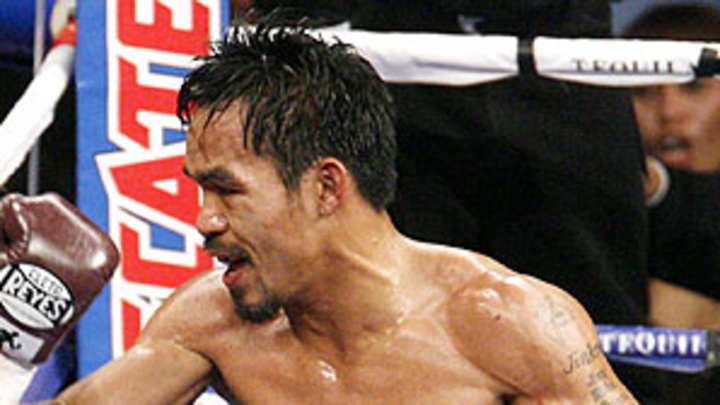A tale of two left hands


The left jab of Oscar De La Hoya was widely expected to be the difference-maker in his welterweight showdown with Manny Pacquiao, the lightweight champion making his first fight above the 135-pound limit.
Until Pacquiao's own left hand flipped the script.
A volume puncher who made his pro debut at 108 pounds, Pacquiao entered Saturday night's bout atop the sport's mythical pound-for-pound rankings. But the physical concessions he'd be making against De La Hoya -- four inches in height and six inches in reach -- made the public somewhat pessimistic about his chances. Same for the oddsmakers, who installed Pacquiao as a 2-to-1 longshot.
Many observers expected the Golden Boy to pump his left jab and keep Pacquiao on the outside, thus neutralizing the Filipino's awesome interior punching ability. But De La Hoya, either unwilling or unable to press those advantages in the first round, appeared doomed from jump street. He was sluggish and disturbingly passive, allowing Pacquiao to establish a vigorous pace and keep the action in the middle of the ring -- the ideal locale for his stick-and-move strategy.
Instead of De La Hoya using his left jab to control the fight, it was Pacquiao who used dozens of left-hand leads to punish the Golden Boy throughout eight lopsided rounds. De La Hoya's trainer, Nacho Beristain, threw in the towel before the ninth-round bell, sealing a deserved TKO victory for the Pambansang Kamao -- or National Fist -- of the Philippines.
For a southpaw like Pacquiao, the left-hand lead is a dangerous punch because it takes longer to arrive and opens the body to the opponent, leaving the thrower vulnerable to a counterpunch. But after exposing the 35-year-old De La Hoya as too slow to make him pay for it, Pacquiao began leading with more and more left hands. They came in two varieties. The first was the short quick slip, more disconcerting than damaging, intended to sustain the pressure and keep De La Hoya on the defensive. The second was the "offense" punch, the power shots which pummeled the right side of De La Hoya's face and body with higher frequency as the night advanced.
Pacquiao made himself an elusive target throughout the night, bouncing around the ring like a tween off his Ritalin, a credit to his freakish conditioning regimen. It was just Manny being Manny, constantly turning De La Hoya's body from side to side, keeping his opponent off balance and refusing to allow the Golden Boy to fight straight ahead -- his preferred style. By the seventh, an emboldened Pacquiao moved in for the knockout, effortlessly evading De La Hoya's half-hearted jabs. A flurry of movement, Pacquiao connected on 45 power punches in the round -- the highest single-round total against De La Hoya in 31 fights tracked by CompuBox. When De La Hoya went nearly two minutes without throwing a meaningful punch during one memorable stretch, the outcome seemed inevitable.
Checkmate came in the eighth when De La Hoya took cover beneath an avalanche of Pacquiao punches and a bloodletting seeming imminent. Beristain was wise to stop the fight when he did.
Many believe Pacquiao will drop down to 140 pounds and seek Ricky Hatton's junior welterweight title in his next bout. But with rumblings of a large-scale payday between Pacquiao and Floyd Mayweather, Jr., picking up steam in the hours since the Filipino's stunning victory, don't be surprised to see the Pretty Boy make a comeback from retirement to accommodate Pacquiao in a sophomore outing at welterweight.
In the hours before Saturday night's main event, Pacquiao insisted De La Hoya's left jab wasn't a concern from his point of view.
"We have a lot of strategy for his left hand," Pacquiao told HBO's LarryMerchant. "We focused on his left hand on our training every day."
Pac-Man's focus paid dividends Saturday in a big way -- opening the door for bigger and better opportunities in the months to come.
